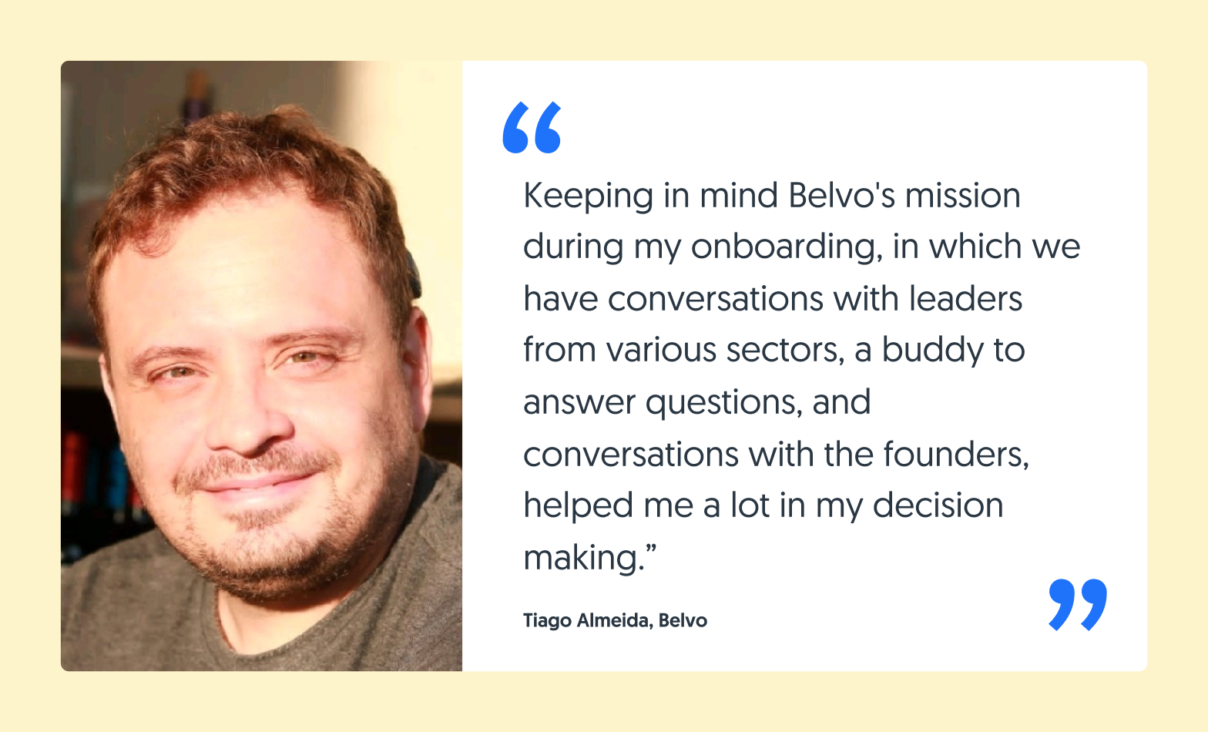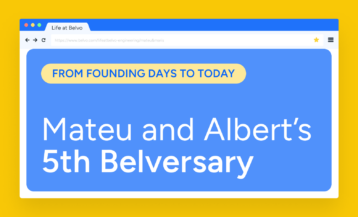The experience of joining a new company is always challenging. The euphoria for having been accepted mixes with “butterflies in the stomach”for not knowing the people or the culture of the company. I was approved, now what? What does the company expect from me? I realized that these feelings happen regardless of seniority or professional maturity.
I have been through this process a few times before, but the experience I am having at Belvo as Engineering Manager has been so good that it encouraged me to write this article and, who knows, help others.
In my professional career, I’ve had some pretty disorganized experiences in the early routine at other companies, where I would basically get access to the code repository with some simpler task to solve, or be asked to have a whole week “stuffed” with context and integration meetings. But a good onboarding process goes far beyond knowledge of areas like HR and the perks offered by the company, and many still don’t realize this.
Therefore, based on my experience at Belvo, I have put together some points that I consider vital for a successful onboarding.
1. “Starting at the Beginning”
Every onboarding should start with Vision, Mission and Values, and this was very clear during Belvo’s process. These factors are fundamental for everyone’s success. And we, as new employees, should seek this information as soon as possible, so that we can align our work proposals with the company’s culture.
There are many ways to get this information, but the best way to do this is through people, from the founders, through leaders of the various departments, in short, through all those who came before us.
Keeping this in mind during my onboarding at Belvo, in which we have conversations with leaders from various sectors, a buddy to answer questions, and conversations with the founders, helped me a lot in my decision making.

2. Understanding the Basics of Business
Whatever your position, it is fundamental to have a good knowledge of the business so that your decisions adhere to the company’s objectives.
Usually companies provide a considerable amount of documentation about this, but don’t stop there… Talk to people to understand in practice how their role can affect the customer. With this in mind you gain an overall view, and planning your tasks becomes easier.
An interesting way to do this might be, following another example I had at Belvo, with product demos, in which the employee goes through the customer experience for a day.
3. Knowing the current objectives
Several companies use methodologies to create and track their main objectives, such as the OKR (Objectives and Key Results), method applied by Belvo. Understanding the larger objectives and how they break down to your team is an important guide for planning and executing tasks.
Keeping these goals in mind is a great way to figure out if the day-to-day tasks make sense.
4. Meeting the key people
Besides knowing very well the team you are going to work with, it is important to know that there are several people from the most diverse departments that can help a lot on a daily basis. A company is divided into departments, but in the end everything has to work together to achieve success, and for this communication is fundamental.
Talk to people at both the strategic and operational levels. They will all give valuable input, and it will also help create relationships that are valuable in communicating across departments.
5. Understanding the work processes
It is essential to know the work processes already established before making any suggestions from lived experiences and other organizations: each company has its culture and not always what was successful in the past applies in the present, and this also applies to failures.
Therefore, seeking to understand how these processes work helps in a better integration. At Belvo, these documentations were very detailed to help newcomers in the process – but if the company doesn’t have documentation about these processes, this is a good time to build it. Over time you can suggest improvements if you spot problems and opportunities.
6. Getting to know the management applications
You will probably use daily or weekly internal applications that help you on a daily basis, such as websites that help you manage teams or hire people. Knowing the details of these tools can enhance your integration, besides helping you use the resources more efficiently. Make a list of what you think is important and ask for help to solve doubts.
Here at Belvo we use Notion to centralize all the documentation that I mentioned in the examples above. It is important to leave all documentation in the same place, because it makes information management much easier. Also, this tool can connect to other tools we use like Jira, Slack or Github.
7. Digging into the technical part
This is the part that will differentiate you the most (depending on the position). In my case, understanding the language and architecture of the implementations is essential. Even for those who are already familiar with the technical part, it is important to remember that each place has its own specificity and therefore it is fundamental to understand the details.
A well-planned onboarding is beneficial for all involved
These were strategic points that made my first steps at Belvo much more efficient and enjoyable, taking the burden off of a phase where you have to deal with a lot of new things. And remember: it often takes a long time, even months, to do all this, so there is no sense in trying to rush the steps.
Besides the meetings in several areas that were already pre-scheduled in the calendar, some of them were recorded. This was very interesting because I could fit in the moments that were most interesting, besides being able to review them whenever I needed to.
Many of these points were in Belvo’s official onboarding schedule but another part of it was in a planning thought up by my leadership with the relevant parts to my position.
When this care is noticed with the arrival of a new member of the company, it is (super) very clear how important it is that the person enters in the best possible way.
Did you enjoyed these tips? How about putting them into practice? And if for some reason you didn’t have such a good experience, it’s important to remember that you can be part of changing the culture of your company. Try to remember all the difficulties you had and help form an onboarding manual, and more than that, help build the specific guide for the people who will work with you.
Success always!




